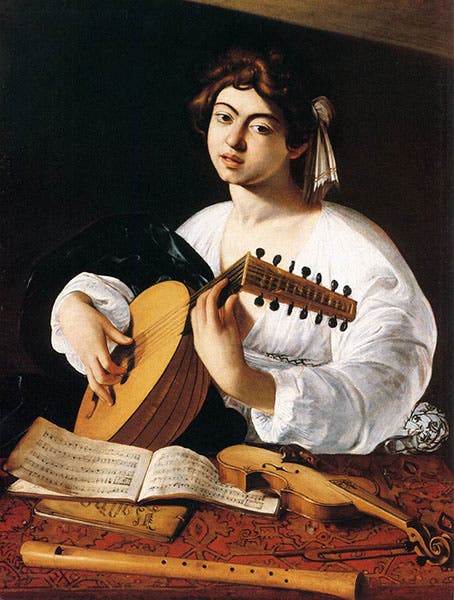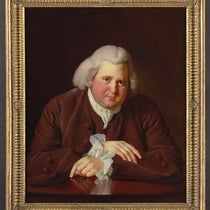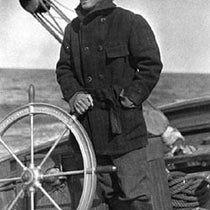Scientist of the Day - Vincenzo Galilei
Vincenzo Galilei, an Italian musician, lute player, and father of Galileo Galilei, died July 2, 1591, at the age of about 70. Vincenzo was a pupil of Gioseffo Zarlino, one of the most significant music theorists of the 16th century, and in the 1580s, Zarlino and Vincenzo engaged in an acrimonious debate about proper tuning intervals in music. Zarlino was an advocate of using pure Pythagorean tunings, where the interval of a fifth, for example, is generated by the ratio 3:2. The problem with pure tunings of fourths and fifths is that other intervals are dissonant, and one cannot easily change keys. Vincenzo argued for a tempered system, with the fifths slightly flattened, which the human voice can do easily, and which the human ear can forgive just as easily. Vincenzo maintained that musical practice, rather than some arbitrary ratios of small numbers, should be the determining factor in harmony.
Vincenzo also apparently did experiments to discover the factors that determine tuning in strings. It had been known since antiquity that if you change the length of a string, for example, shorten it with a fret, then the tone goes up, and the change is directly proportional to the change in length of the string. For example, two otherwise identical strings whose lengths are in the ratio of 2:1 will sound an octave apart, while strings in the ratio of 3:2 will produce a musical fifth (C to G, for example), and 4:3, a musical fourth (C to F). Vincenzo did experiments in which he hung weights from strings over pulleys to produce tension, and he discovered that if you measured the weights instead of the string lengths, then a change of an octave is produced by quadrupling the weight, and a fifth by weights in the proportion of 9:4. Why, then, should 1,2,3, 4 be the privileged numbers in Pythagorean tuning, when it could just as well be 1, 4, 9, 16, if you are talking about tension.
It has often been maintained that Vincenzo’s son, Galileo, learned to prefer the evidence of experiment, rather than authority, from his father. The only problem with this argument is that Vincenzo, in other ways, was very much a traditionalist. For example, Zarlino was an advocate of the new art of polyphony, the playing or singing of several voices at once, while Vincenzo adamantly supported monody, the musical style of antiquity, where single notes succeed one another. Also, Vincenzo wrote in Italian, in which language esperienza or sperienza can mean either experience or experiment. So it is not always clear whether Vincenzo has learned something by observation (esperienza) or by doing an experiment (also espereinza). Vincenzo related that he had determined by esperienza that the tone of an organ pipe depends on the volume of air within, which is not true (only the length affects the tone), so either he did this experiment badly, or he did not do any experiments on the matter at all.
Still, Galileo was probably living at home in Pisa in 1588, when Vincenzo did his experiments in hanging weights from strings, and it is about this time that Galileo became interested in the laws regulating pendulums, which you see a lot of when you hang weights on strings, so something may well have rubbed off from father to son. And Vincenzo did teach Galileo to play the lute, but he did a much better job with his other son, Michelagnolo, who became quite a distinguished lutenist and earned his living playing and composing at the Bavarian court in Munich, when he wasn’t bugging older brother Galileo for money to support his family.
There is not a lot to display by way of graphics for Vincenzo. There is no surviving portrait, and the house n Pisa that he lived in is not known, as far as I am aware. There is a street marker in Pisa that we show you (second image), but that is about it. Many of Vincenzo’s madrigals and compositions for lute survive, but they don’t seem appropriate for this medium, although here is one, a galliard for lute, and you can find many more on YouTube. So, in desperation, we include one of three versions of Caravaggio’s painting The Lute Player, completed shortly after Vincenzo’s death (and not depicting Vincenzo) (first image). I do not like it quite as well as The Lute Player by Franz Hals, or Jan Steen’s self-portrait with a lute, but those postdate Vincenzo by quite a few decades. Caravaggio will have to do.
William B. Ashworth, Jr., Consultant for the History of Science, Linda Hall Library and Associate Professor emeritus, Department of History, University of Missouri-Kansas City. Comments or corrections are welcome; please direct to ashworthw@umkc.edu.






![Using an astrolabe to measure the depth of a well, woodcut in Elucidatio fabricae vsusq[ue] astrolabii, by Johannes Stöffler, 1513 (Linda Hall Library)](https://assets-us-01.kc-usercontent.com:443/9dd25524-761a-000d-d79f-86a5086d4774/a998eb50-55d2-4a88-ace2-a50aa5fa86e7/Stoffler%201.jpg?w=210&h=210&auto=format&fit=crop)

